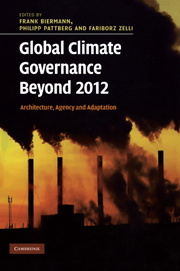Book contents
- Frontmatter
- Contents
- List of contributors
- Preface
- List of abbreviations
- 1 Global climate governance beyond 2012
- Part I Architecture
- Part II Agency
- Part III Adaptation
- 14 Global adaptation governance
- 15 Costs, benefits and interlinkages between adaptation and mitigation
- 16 Global adaptation governance
- 17 Global adaptation governance beyond 2012
- 18 Shaping future adaptation governance
- 19 Conclusions
- Index
- References
18 - Shaping future adaptation governance
perspectives from the poorest of the poor
Published online by Cambridge University Press: 05 July 2014
- Frontmatter
- Contents
- List of contributors
- Preface
- List of abbreviations
- 1 Global climate governance beyond 2012
- Part I Architecture
- Part II Agency
- Part III Adaptation
- 14 Global adaptation governance
- 15 Costs, benefits and interlinkages between adaptation and mitigation
- 16 Global adaptation governance
- 17 Global adaptation governance beyond 2012
- 18 Shaping future adaptation governance
- 19 Conclusions
- Index
- References
Summary
Introduction
Adaptation to climate change impacts has eventually become widely accepted in science and climate policy as an inevitable social process in need of extensive funding and explicit action (Stern 2006; Pielke et al. 2007). From a geopolitical perspective the promotion of adaptation is a step forward to overcome political tensions between a focus on mitigation in richer countries versus a focus on adaptation in poorer countries.
From a sustainability point of view it is of great concern to ensure that adaptation reaches and involves vulnerable people in places exposed to climate change impacts and responses. The acceptance and promotion of adaptation in science and policy circles alike may represent a promise for such vulnerable communities where adaptation is to be translated into short-term practices and longer-term livelihood strategies. For adaptation to be successful, the local level must be bridged in an effective way with the global level where funds and mechanisms are available. The bridging between the local and the global creates challenges for science and policy. A first challenge is to organize participatory learning processes where local experiences and priorities in vulnerable communities can be used as a knowledge basis for adaptation. A second challenge is to mobilize sufficient global funds for adaptation and make them available for local adaptation needs. Even though the global policy framework is adjusting to generate funds for adaptation, this is at much lower levels than for mitigation (Müller 2006, 2007; Möhner and Klein 2007). The low funding for adaptation is unfortunate for several reasons. First, adaptation is a legal obligation of the rich countries towards poorer countries to be paid as a compensation for historical inequalities in emissions. Second, adaptation is a moral obligation of the world’s less vulnerable people towards the more vulnerable people across the world who are increasingly exposed to natural hazards, climate variability and climate change now and in the future (Paavola and Adger 2006). Among those who are vulnerable to climate change impacts and climate change responses certain people are even more vulnerable and also difficult to reach with policies and measures. This group we call the poorest of the poor.
- Type
- Chapter
- Information
- Global Climate Governance Beyond 2012Architecture, Agency and Adaptation, pp. 286 - 305Publisher: Cambridge University PressPrint publication year: 2010
References
- 5
- Cited by



